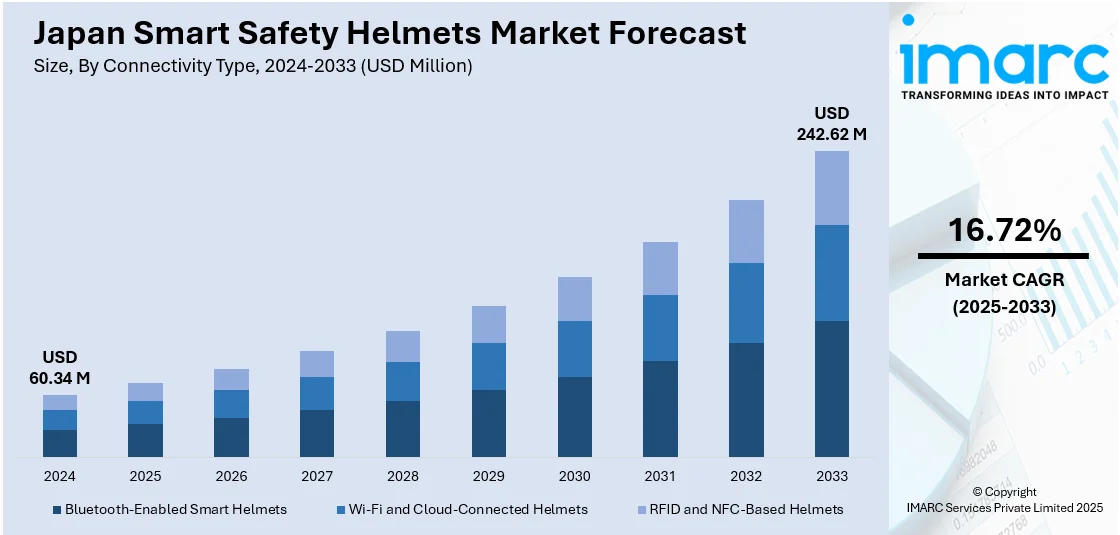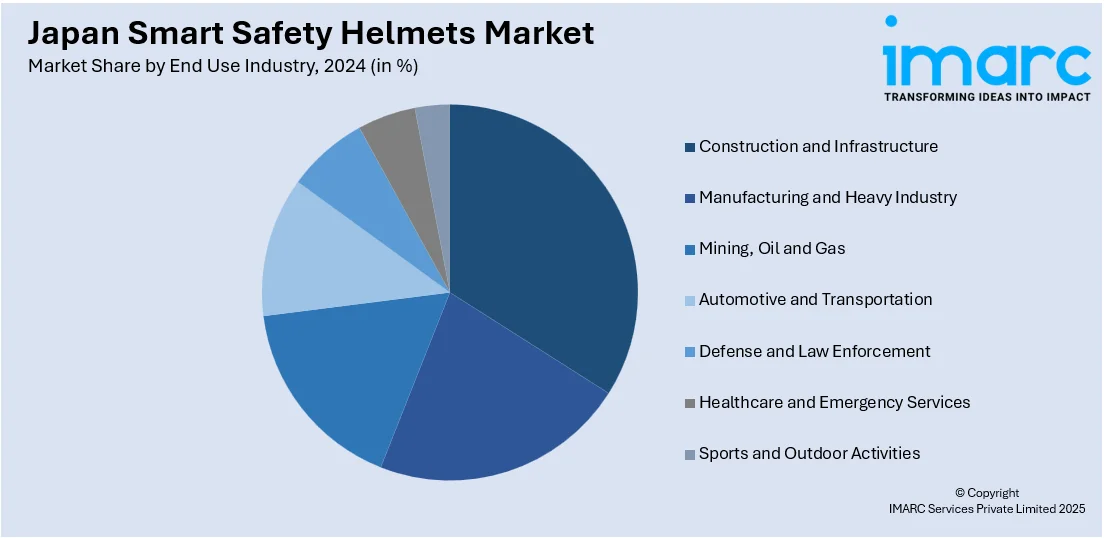
Japan Smart Safety Helmets Market Size, Share, Trends and Forecast by Technology Type, Connectivity Type, Material Type, Safety Features, End Use Industry, and Region, 2025-2033
Japan Smart Safety Helmets Market Overview:
The Japan smart safety helmets market size reached USD 60.34 Million in 2024. Looking forward, IMARC Group expects the market to reach USD 242.62 Million by 2033, exhibiting a growth rate (CAGR) of 16.72% during 2025-2033. The market is experiencing steady growth, driven by rising demand in construction, mining, and manufacturing sectors. Increasing workplace safety regulations and integration of IoT technologies, including real-time monitoring and communication features, are also boosting adoption. Domestic companies focusing on innovation, partnerships with global tech firms enhancing product capabilities and urban infrastructure development are further contributing positively to the Japan smart safety helmets market share.
|
Report Attribute
|
Key Statistics
|
|---|---|
|
Base Year
|
2024 |
|
Forecast Years
|
2025-2033
|
|
Historical Years
|
2019-2024
|
| Market Size in 2024 | USD 60.34 Million |
| Market Forecast in 2033 | USD 242.62 Million |
| Market Growth Rate 2025-2033 | 16.72% |
Japan Smart Safety Helmets Market Trends:
Integration of IoT and AI
The convergence of Internet of Things (IoT) and Artificial Intelligence (AI) is transforming the smart safety helmets' functionality in Japan. These technologies allow real-time monitoring of workers through sensors embedded in the helmets tracking location, movement, temperature, and exposure to toxic gas or noise. AI processing software interprets this information to identify early indications of fatigue, identify dangerous behavior, and initiate immediate alerts to managers. This not only enhances the safety of individual workers but also the overall site efficiency by avoiding accidents and downtime. Japanese companies are actively working on developing AI-enabled helmets with predictive capabilities to identify threats before they become major issues. The wide availability of 5G networks also facilitates easy connectivity and faster transmission of data from helmet sensors to centralized safety systems. These innovations are a testament to Japan's focus on utilizing leading-edge technology for workplace safety and operational excellence.

Rising Adoption in Construction and Industrial Sectors
Japan’s construction, logistics, and manufacturing sectors are rapidly embracing smart safety helmets due to an increasing emphasis on occupational safety and regulatory compliance. With aging infrastructure projects and labor-intensive work environments, these industries are under pressure to reduce workplace accidents and improve operational oversight. Smart helmets equipped with sensors, GPS, and communication tools are proving essential in monitoring real-time conditions and ensuring adherence to safety protocols. In logistics and warehousing, helmets help track worker movements and environmental factors, minimizing risk and enhancing productivity. The manufacturing sector, particularly in high-risk settings, uses smart helmets to identify machine-related hazards and protect workers during complex operations. Rising awareness of the long-term cost savings from accident prevention and efficiency gains is further fueling adoption. This cross-industry integration of smart wearable technology is a major factor driving the Japan smart safety helmets market growth.
Remote Monitoring Capabilities Enhancing On-Site Safety
Remote monitoring has become a critical feature driving the appeal of smart safety helmets in Japan. Helmets equipped with built-in cameras, GPS, and wireless connectivity allow supervisors and safety managers to view real-time footage of on-site activities, regardless of their physical location. This capability is especially valuable in large construction projects, hazardous industrial zones, and remote logistics operations where on-the-ground supervision may be limited. Live video feeds and sensor data help identify unsafe behavior, assess environmental conditions, and intervene promptly in case of emergencies. It also aids in documenting compliance for audits and training purposes. The ability to connect field workers to control rooms or command centers enhances coordination, reduces response time during incidents, and promotes a culture of accountability. This growing demand for connected, camera-enabled helmets underscores a strong shift toward digital oversight in Japan’s workplace safety practices.
Japan Smart Safety Helmets Market Segmentation:
IMARC Group provides an analysis of the key trends in each segment of the market, along with forecasts at the country and regional levels for 2025-2033. Our report has categorized the market based on technology type, connectivity type, material type, safety features, and end use industry.
Technology Type Insights:
- IoT-Enabled Smart Helmets
- Augmented Reality (AR) and Heads-Up Display (HUD) Helmets
- AI-Powered Safety Helmets
- Sensor-Based Smart Helmets
- GPS-Enabled Helmets
- Communication-Integrated Helmets
The report has provided a detailed breakup and analysis of the market based on the technology type. This includes IoT-enabled smart helmets, augmented reality (AR) and heads-up display (HUD) helmets, AI-powered safety helmets, sensor-based smart helmets, GPS-enabled helmets, and communication-integrated helmets.
Connectivity Type Insights:
- Bluetooth-Enabled Smart Helmets
- Wi-Fi and Cloud-Connected Helmets
- RFID and NFC-Based Helmets
A detailed breakup and analysis of the market based on the connectivity have also been provided in the report. This includes Bluetooth-enabled smart helmets, Wi-Fi and cloud-connected helmets, and RFID and NFC-based helmets.
Material Type Insights:
- Polycarbonate Helmets
- Fiberglass and Composite Helmets
- ABS Plastic Helmets
- Carbon Fiber Helmets
A detailed breakup and analysis of the market based on the material type have also been provided in the report. This includes polycarbonate helmets, fiberglass and composite helmets, ABS plastic helmets, and carbon fiber helmets.
Safety Features Insights:
- Real-Time Health Monitoring
- Fall and Impact Detection
- Noise Cancellation and Communication Enhancement
- Fire and Hazard Detection
- Environmental Monitoring
- Smart Lighting and Alerts
A detailed breakup and analysis of the market based on the safety features have also been provided in the report. This includes real-time health monitoring, fall and impact detection, noise cancellation and communication enhancement, fire and hazard detection, environmental monitoring, and smart lighting and alerts.
End Use Industry Insights:

- Construction and Infrastructure
- Manufacturing and Heavy Industry
- Mining, Oil and Gas
- Automotive and Transportation
- Defense and Law Enforcement
- Healthcare and Emergency Services
- Sports and Outdoor Activities
A detailed breakup and analysis of the market based on the end use industry have also been provided in the report. This includes construction and infrastructure, manufacturing and heavy industry, mining, oil and gas, automotive and transportation, defense and law enforcement, healthcare and emergency services, and sports and outdoor activities.
Regional Insights:
- Kanto Region
- Kansai/Kinki Region
- Central/Chubu Region
- Kyushu-Okinawa Region
- Tohoku Region
- Chugoku Region
- Hokkaido Region
- Shikoku Region
The report has also provided a comprehensive analysis of all the major regional markets, which include Kanto Region, Kansai/Kinki Region, Central/Chubu Region, Kyushu-Okinawa Region, Tohoku Region, Chugoku Region, Hokkaido Region, and Shikoku Region.
Competitive Landscape:
The market research report has also provided a comprehensive analysis of the competitive landscape. Competitive analysis such as market structure, key player positioning, top winning strategies, competitive dashboard, and company evaluation quadrant has been covered in the report. Also, detailed profiles of all major companies have been provided.
Japan Smart Safety Helmets Market News:
- In March 2024, Yamaha announced its plans to advance augmented reality (AR) technology for motorcycle helmets, integrating HUD elements without obstructing riders' vision. Their new patent includes multiple cameras to track eye movements and overlay information.
- In January 2024, Nissan launched the e-MOTION HelMet, a groundbreaking helmet enabling hands-free driving on a virtual circuit through emotional cues. Developed with the University of Texas, it aims to enhance mobility for all, including those with disabilities. The technology also builds on Nissan’s Brain to Vehicle innovations for improved driving experiences.
Japan Smart Safety Helmets Market Report Coverage:
| Report Features | Details |
|---|---|
| Base Year of the Analysis | 2024 |
| Historical Period | 2019-2024 |
| Forecast Period | 2025-2033 |
| Units | Million USD |
| Scope of the Report | Exploration of Historical Trends and Market Outlook, Industry Catalysts and Challenges, Segment-Wise Historical and Future Market Assessment:
|
| Technology Types Covered | IoT-Enabled Smart Helmets, Augmented Reality (AR) and Heads-Up Display (HUD) Helmets, AI-Powered Safety Helmets, Sensor-Based Smart Helmets, GPS-Enabled Helmets, Communication-Integrated Helmets |
| Connectivity Types Covered | Bluetooth-Enabled Smart Helmets, Wi-Fi and Cloud-Connected Helmets, RFID and NFC-Based Helmets |
| Material Types Covered | Polycarbonate Helmets, Fiberglass and Composite Helmets, ABS Plastic Helmets, Carbon Fiber Helmets |
| Safety Features Covered | Real-Time Health Monitoring, Fall and Impact Detection, Noise Cancellation and Communication Enhancement, Fire and Hazard Detection, Environmental Monitoring, Smart Lighting & Alerts |
| End-Use Industries Covered | Construction and Infrastructure, Manufacturing and Heavy Industry, Mining, Oil and Gas, Automotive and Transportation, Defense and Law Enforcement, Healthcare and Emergency Services, Sports and Outdoor Activities |
| Regions Covered | Kanto Region, Kansai/Kinki Region, Central/Chubu Region, Kyushu-Okinawa Region, Tohoku Region, Chugoku Region, Hokkaido Region, and Shikoku Region. |
| Customization Scope | 10% Free Customization |
| Post-Sale Analyst Support | 10-12 Weeks |
| Delivery Format | PDF and Excel through Email (We can also provide the editable version of the report in PPT/Word format on special request) |
Key Questions Answered in This Report:
- How has the Japan smart safety helmets market performed so far and how will it perform in the coming years?
- What is the breakup of the Japan smart safety helmets market on the basis of technology type?
- What is the breakup of the Japan smart safety helmets market on the basis of connectivity type?
- What is the breakup of the Japan smart safety helmets market on the basis of material type?
- What is the breakup of the Japan smart safety helmets market on the basis of safety features?
- What is the breakup of the Japan smart safety helmets market on the basis of end use industry?
- What is the breakup of the Japan smart safety helmets market on the basis of region?
- What are the various stages in the value chain of the Japan smart safety helmets market?
- What are the key driving factors and challenges in the Japan smart safety helmets market?
- What is the structure of the Japan smart safety helmets market and who are the key players?
- What is the degree of competition in the Japan smart safety helmets market?
Key Benefits for Stakeholders:
- IMARC’s industry report offers a comprehensive quantitative analysis of various market segments, historical and current market trends, market forecasts, and dynamics of the Japan smart safety helmets market from 2019-2033.
- The research report provides the latest information on the market drivers, challenges, and opportunities in the Japan smart safety helmets market.
- Porter's five forces analysis assist stakeholders in assessing the impact of new entrants, competitive rivalry, supplier power, buyer power, and the threat of substitution. It helps stakeholders to analyze the level of competition within the Japan smart safety helmets industry and its attractiveness.
- Competitive landscape allows stakeholders to understand their competitive environment and provides an insight into the current positions of key players in the market.
Need more help?
- Speak to our experienced analysts for insights on the current market scenarios.
- Include additional segments and countries to customize the report as per your requirement.
- Gain an unparalleled competitive advantage in your domain by understanding how to utilize the report and positively impacting your operations and revenue.
- For further assistance, please connect with our analysts.
 Request Customization
Request Customization
 Speak to an Analyst
Speak to an Analyst
 Request Brochure
Request Brochure
 Inquire Before Buying
Inquire Before Buying




.webp)




.webp)












